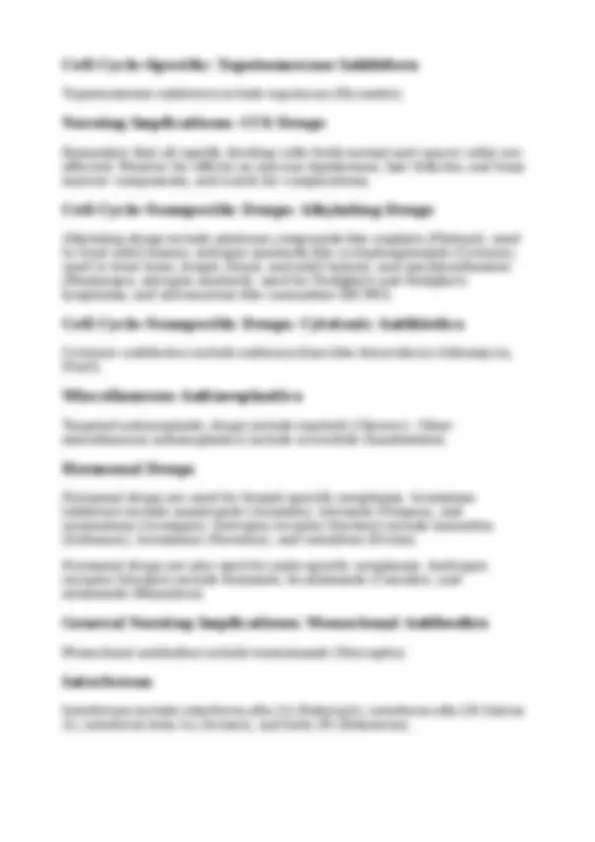



Study with the several resources on Docsity

Earn points by helping other students or get them with a premium plan


Prepare for your exams
Study with the several resources on Docsity

Earn points to download
Earn points by helping other students or get them with a premium plan
Community
Ask the community for help and clear up your study doubts
Discover the best universities in your country according to Docsity users
Free resources
Download our free guides on studying techniques, anxiety management strategies, and thesis advice from Docsity tutors
An overview of drugs used to treat cancer, focusing on antineoplastic drugs and their mechanisms of action. It covers various drug classes, including cell cycle-specific and non-specific drugs, their indications, contraindications, and adverse effects. The presentation includes questions to test understanding and highlights nursing implications for administering these medications. It is useful for students and healthcare professionals seeking to understand cancer pharmacology. A useful resource for understanding the complexities of cancer treatment through pharmacological interventions. It offers a structured approach to learning about different drug classes and their specific roles in combating cancer. The inclusion of questions and nursing implications enhances its practical value for healthcare professionals.
Typology: Summaries
1 / 2

This page cannot be seen from the preview
Don't miss anything!


Cancer treatment includes surgery, radiation therapy, and chemotherapy.
Malignant neoplasm is a technical term for cancer. Antineoplastic drugs are used to treat cancer and are also called cancer drugs, anticancer drugs, cytotoxic chemotherapy, or just chemotherapy.
Chemotherapy is the pharmacologic treatment of cancer using antineoplastic drugs. These drugs are divided into two groups based on where they work in the cellular life cycle: cell cycle-nonspecific (CCNS) and cell cycle-specific (CCS). Some drugs have characteristics of both.
Chemotherapy drugs have a narrow therapeutic index. Combination drug therapy is usually more effective than single-drug therapy. Drug resistance is a common issue. Nearly all drugs cause adverse effects, including dose- limiting adverse effects. Chemotherapy is harmful to all rapidly growing cells, including cancer cells and healthy normal human cells like hair follicles, gastrointestinal (GI) tract cells, and bone marrow cells.
Antimetabolites include folate (folic acid) analogs like methotrexate (MTX), pemetrexed, and pralatrexate; pyrimidine analogs like cytarabine (Cytosar- U, DepoCyt); and purine analogs like mercaptopurine (Purinethol).
Methotrexate is an anticancer drug commonly used to treat rheumatoid arthritis (RA) in much lower doses, administered weekly. Adverse effects include bone marrow suppression. Folic acid supplements are advised to lessen the likelihood of adverse effects. It takes 3 to 6 weeks for the onset of antirheumatic action.
Mitotic inhibitors include vinca alkaloids like vincristine and vinblastine (Velban), and taxanes like paclitaxel (Taxol, Abraxane).
Topoisomerase inhibitors include topotecan (Hycamtin).
Remember that all rapidly dividing cells (both normal and cancer cells) are affected. Monitor for effects on mucous membranes, hair follicles, and bone marrow components, and watch for complications.
Alkylating drugs include platinum compounds like cisplatin (Platinol), used to treat solid tumors; nitrogen mustards like cyclophosphamide (Cytoxan), used to treat bone, lymph, blood, and solid tumors, and mechlorethamine (Mustargen, nitrogen mustard), used for Hodgkin's and Hodgkin's lymphoma; and nitrosoureas like carmustine (BiCNU).
Cytotoxic antibiotics include anthracyclines like doxorubicin (Adriamycin, Doxil).
Targeted antineoplastic drugs include imatinib (Gleevec). Other miscellaneous antineoplastics include octreotide (Sandostatin).
Hormonal drugs are used for female-specific neoplasms. Aromatase inhibitors include anastrozole (Arimidex), letrozole (Femara), and exemestane (Aromasin). Estrogen receptor blockers include tamoxifen (Soltamox), toremifene (Fareston), and raloxifene (Evista).
Hormonal drugs are also used for male-specific neoplasms. Androgen receptor blockers include flutamide, bicalutamide (Casodex), and nilutamide (Nilandron).
Monoclonal antibodies include trastuzumab (Herceptin).
Interferons include interferon alfa-2A (RoferonA), interferon alfa-2B (Intron A), interferon beta-1a (Avonex), and beta-1B (Betaseron).